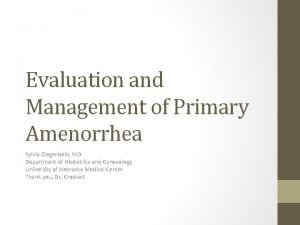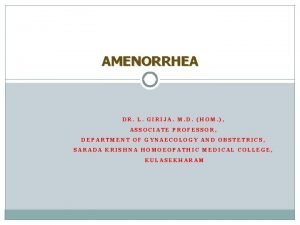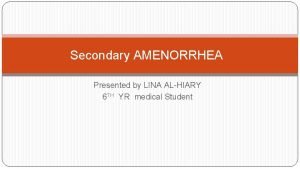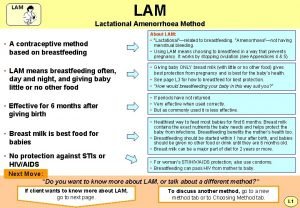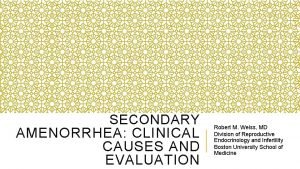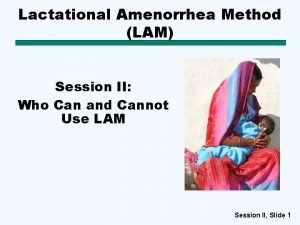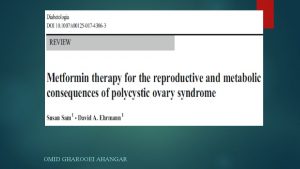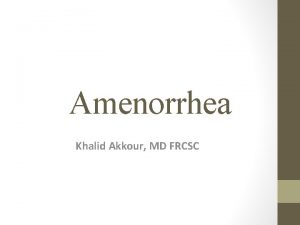Primary amenorrhea Omid gharooi Ahangar Diagnostic clue in




















- Slides: 20

Primary amenorrhea Omid gharooi Ahangar

Diagnostic clue in this patient • Primary amenorrhea • Normal Thelarche and Pubarche • Normal IQ • Growth retardation • Normal FSH • Absence of uterine or hypoplastic • Karyotype XX

agenda • What is DDx of primary amenorrhea in presence of normal secondary sexual characteristics? • How approach to primary amenorrhea? • Is there relationship between primary amenorrhea and growth failure in this patient ? • What is next plan and management?


Primary Amenorrhea: Etiology § Pregnancy § Thyroid disease § Hyperprolactinemia § Prolactinoma § Hypergonadotropic hypogonadism § Gonadal dysgenesis (i. e. Turner syndrome) § Premature ovarian failure § Hypogonadotropic hypogonadism § § Constitutional delay of puberty Congenital Gn. RH deficiency (Kallman syndrome) Functional hypothalamic amenorrhea (i. e. Anorexia or Bulimia nervosa) CNS tumor (i. e. Craniopharyngioma) § Normogonadotropic § Congenital (i. e. Mullerian agenesis, Androgen Insensitivity syndrome) § Outflow tract obstruction (i. e. Imperforate hymen, Transverse vaginal septum) § Hyperandrogenic anovulation (i. e. PCOS, Cushing’s disease)

Etiology prevalence • Chromosomal abnormalities causing gonadal dysgenesis (ovarian failure due to the premature depletion of all oocytes and follicles) — 50 percent • Hypothalamic hypogonadism including functional hypothalamic amenorrhea — 20 percent • Absence of the uterus, cervix and/or vagina, müllerian agenesis — 15 percent • Transverse vaginal septum or imperforate hymen — 5 percent • Pituitary disease — 5 percent • The remaining 5 percent of cases are due to a combination of disorders including androgen insensitivity due to mutations in the androgen receptor, congenital adrenal hyperplasia, and polycystic ovary syndrome

DIAGNOSTIC EVALUATION Primary amenorrhea is evaluated most efficiently by focusing on: • the presence or absence of breast development (a marker of estrogen action and therefore function of the ovary), • the presence or absence of the uterus (as determined by ultrasound, or in more complex cases by magnetic resonance imaging) • and the FSH level.

scenario I. If there is no breast development and the FSH level is elevated, the probable diagnosis is gonadal dysgenesis, and a karyotype should be obtained II. If the ultrasound indicates that the uterus is absent and FSH is normal, the probable diagnosis is müllerian agenesis or androgen insensitivity syndrome. In the case of müllerian agenesis, the circulating testosterone is in the normal range for women and in the case of androgen insensitivity, the circulating testosterone is in the male range. III. If the FSH is normal, and both breast development and the uterus are present, then the work -up should focus on the common causes of secondary amenorrhea, where the initial work up includes measurement of height and weight, serum FSH, prolactin and TSH.

Primary Amenorrhea • Is there normal development of secondary sexual characteristcs? NO Think hypogonadism or hypogonadotropism

Primary Amenorrhea • Is there normal development of secondary sexual characteristics? YES • Think • Pregnancy beta HCG elevated • Mullerian anomaly normal androgen level • Androgen insensitivity elevated testosterone level

Primary Amenorrhea: Evaluation Secondary sexual characteristics present? No Yes Measure FSH Perform ultrasound of uterus Uterus absent or abnormal FSH < 5 FSH > 20 Hypogonadotropic hypogonadism Hypergonadotropic hypogonadism § Hypothalamic amenorrhea § Constitutional delay Karyotype analysis of puberty § Kallman syndrome § CNS tumor 46, XX Premature ovarian failure Uterus present or normal Karyotype analysis Outflow obstruction 46, XY 46, XX No Yes Androgen insensitivity syndrome Mülleria n agenesis Evaluate for 2° amenorrhea Imperforate hymen Transverse vaginal septum 45, XO Turner’s syndrome § PCOS § Cushing’s


Frequency of specific anomalies • A review including a combined population of infertile and fertile women, the frequency of anomalies by type was: • septate (35 percent), • bicornuate (26 percent), • arcuate (18 percent), • unicornuate (10 percent), • didelphys (8 percent), • and agenesis (3 percent)

There are three common developmental defects of the müllerian system to consider: • Agenesis • Lateral fusion defects • Vertical fusion defects

Agenesis • The Mayer-Rokitansky-Küster-Hauser (MRKH) syndrome refers to congenital absence of the vagina with variable uterine development; it is the result of müllerian agenesis. Variable uterine development may result in lateral hemi-uteri or uterine horns, a midline uterus without a cervix, or no uterine structures at all.

• Is there any association between MRKH and growth failure?


• Isolated utero-vaginal aplasia is referred to as Rokitansky sequence or to type I (isolated) MRKH syndrome. Incomplete aplasia and/or associated with other malformations, is generally referred to as MURCS association (or type II MRKH syndrome). In this case, the term GRES (Genital Renal Ear Syndrome) can also be used.

Associated malformations in MRKH syndrome type II • upper urinary tract malformations • hearing impairment • heart malformations • skeletal abnormalities These anomalies mainly involve the spine (30 to 40%) and, less frequently, the face and the limb extremities. Rachidial malformations encountered in MURCS association are scoliosis (20%), isolated vertebral anomalies (asymmetric, fused or wedged vertebrae), Klippel-Feil association (fusion of at least two cervical segments, short neck, low hair line, restriction of neck motion) and/or Sprengel's deformity, rib malformation or agenesis, and spina bifida. Face and limb malformations are mainly brachymesophalangy, ectrodactyly, duplicated thumb, absent radius, atrio-digital dysplasia (Holt-Oram like syndrome) and facial asymmetry.

• Primary vaginal elongation by dilation is the appropriate first-line approach in most patients because it is safer, patient-controlled, and more cost effective than surgery • Evaluation for associated congenital anomalies is essential because up to 53% of patients with müllerian agenesis have concomitant congenital malformations, especially of the urinary tract and skeleton • Although vulvar and vaginal intraepithelial neoplasia are possible, routine cytology testing is not regularly recommended because of the lack of a cervix. • Patients should be given a written medical summary of their condition, including a summary of concomitant malformations. This information may be useful if the patient requires urgent medical care or emergency surgery by a health care provider unfamiliar with müllerian agenesis.
 Omid ahangar
Omid ahangar Primary amenorrhea most common cause
Primary amenorrhea most common cause Primary amenorrhea
Primary amenorrhea Clitiromegaly
Clitiromegaly Primary amenorrhea
Primary amenorrhea Cliteromegly
Cliteromegly Lactational amenorrhea
Lactational amenorrhea Lactational amenorrhea
Lactational amenorrhea Amenorrhea
Amenorrhea Oligomenorrhea and amenorrhea
Oligomenorrhea and amenorrhea Lam contraception
Lam contraception Causes of amenorrhea
Causes of amenorrhea Lactational amenorrhea
Lactational amenorrhea Omid askari
Omid askari Omid jafarinezhad
Omid jafarinezhad Omid asadi artist
Omid asadi artist Omid fekri
Omid fekri Omid jafarinezhad
Omid jafarinezhad Omid fatahi valilai
Omid fatahi valilai Omid kashefi
Omid kashefi Omid parhizkar
Omid parhizkar



